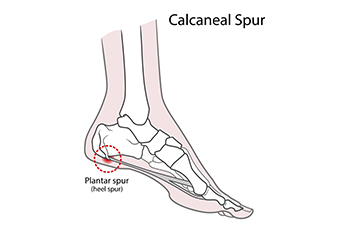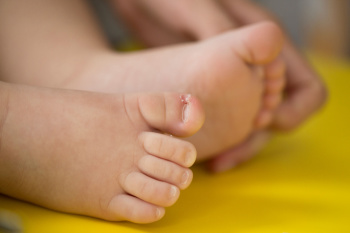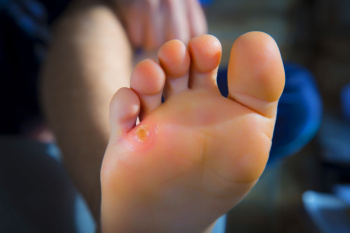Connect With Us
Blog
Items filtered by date: August 2025
Why Live with Pain and Numbness in Your Feet?
Managing Heel Spurs

Heel spurs are bony growths that develop on the underside of the heel bone, often caused by long-term strain on the foot muscles and ligaments. Common causes include repetitive stress from walking or running, wearing poorly fitted shoes, obesity, or conditions like flat feet or high arches. Heel spurs are frequently associated with plantar fasciitis, a painful inflammation of the tissue along the bottom of the foot. Symptoms include sharp, stabbing pain in the heel, especially during the first steps in the morning, or after long periods of rest, along with tenderness, swelling, or a dull ache throughout the day. While some people may not feel any discomfort, others experience persistent pain that affects daily activities. A podiatrist can diagnose a heel spur through a physical exam and confirm the condition with X-rays. Treatment may involve orthotics, targeted exercises, stretching, anti-inflammatory medications, or, in severe cases, surgery. If you have a heel spur, it is suggested that you schedule an appointment with a podiatrist for effective treatment solutions.
Heel spurs can be incredibly painful and sometimes may make you unable to participate in physical activities. To get medical care for your heel spurs, contact one of our podiatrists from Advanced Foot and Ankle Centers, Inc.. Our doctors will do everything possible to treat your condition.
Heels Spurs
Heel spurs are formed by calcium deposits on the back of the foot where the heel is. This can also be caused by small fragments of bone breaking off one section of the foot, attaching onto the back of the foot. Heel spurs can also be bone growth on the back of the foot and may grow in the direction of the arch of the foot.
Older individuals usually suffer from heel spurs and pain sometimes intensifies with age. One of the main condition's spurs are related to is plantar fasciitis.
Pain
The pain associated with spurs is often because of weight placed on the feet. When someone is walking, their entire weight is concentrated on the feet. Bone spurs then have the tendency to affect other bones and tissues around the foot. As the pain continues, the feet will become tender and sensitive over time.
Treatments
There are many ways to treat heel spurs. If one is suffering from heel spurs in conjunction with pain, there are several methods for healing. Medication, surgery, and herbal care are some options.
If you have any questions, please feel free to contact our offices located in Clovis and Madera, CA . We offer the newest diagnostic and treatment technologies for all your foot care needs.
Helping Children with Ingrown Toenails

Ingrown toenails in children occur when the edge of the nail grows into the surrounding skin, leading to pain, redness, and swelling. Common causes include improper nail trimming, wearing tight shoes, genetics, or injury to the toe. Children may complain of tenderness while walking or show signs of infection, such as drainage or increased warmth. Risk factors include curved nails, poor foot hygiene, and active lifestyles that involve repeated pressure on the toes. A podiatrist can gently treat the ingrown nail, relieve discomfort, and provide guidance on prevention. If your child is experiencing toe pain, it is suggested that you promptly schedule a visit to a podiatrist to ensure proper healing.
Making sure that your children maintain good foot health is very important as they grow. If you have any questions, contact one of our podiatrists of Advanced Foot and Ankle Centers, Inc.. Our doctors can provide the care you need to keep you pain-free and on your feet.
Keeping Children's Feet Healthy
Having healthy feet during childhood can help prevent medical problems later in life, namely in the back and legs. As children grow, their feet require different types of care. Here are some things to consider...
Although babies do not walk yet, it is still very important to take care of their feet.
Avoid putting tight shoes or socks on his or her feet.
Allow the baby to stretch and kick his or her feet to feel comfortable.
As a toddler, kids are now on the move and begin to develop differently. At this age, toddlers are getting a feel for walking, so don’t be alarmed if your toddler is unsteady or ‘walks funny’.
As your child gets older, it is important to teach them how to take care of their feet.
Show them proper hygiene to prevent infections such as fungus.
Be watchful for any pain or injury.
Have all injuries checked by a doctor as soon as possible.
Comfortable, protective shoes should always be worn, especially at play.
If you have any questions, please feel free to contact our offices located in Clovis and Madera, CA . We offer the newest diagnostic and treatment technologies for all your foot care needs.
Why Routine Foot Exams Are Essential for Diabetics
Over 38 million Americans are living with diabetes, a common endocrine disease, and if you have diabetes, you’re at increased risk of foot conditions and complications. Diabetes affects the whole body, often in unexpected ways. The feet are one such area, with infections and ulcers potentially serious complications for people with diabetes.
Routine foot exams can help catch these problems before they grow worse. If you or a loved one has diabetes, foot exams should be a regular part of managing the disease. Learn more about the condition and potential issues it can cause for your feet.
What are Diabetic Foot Exams, and Why Do They Matter?
Diabetic foot exams help manage diabetes by spotting potential problems before they become severe. People with diabetes face higher risks of neuropathy and circulation issues, which can lead to unnoticed injuries and slow healing. Slow healing of wounds puts people with diabetes at higher risk of developing infections, and the feet are particularly susceptible to infection due to their contact with the ground and a moist environment from wearing socks and shoes. Regular exams are necessary to catch these issues early.
Ignoring foot health can lead to serious outcomes like infections, ulcers, or amputations. Diabetic neuropathy often reduces foot sensation, so minor injuries might go unnoticed. Poor circulation complicates healing, raising infection risks. Routine exams allow healthcare providers to detect early signs and intervene promptly.
What Goes on During a Diabetic Foot Exam?
A diabetic foot exam is a thorough check-up on nerve health, blood flow, and skin condition. During the exam, healthcare providers assess nerve function using tools like a monofilament to test sensitivity. This helps identify diabetic neuropathy, where nerve damage occurs due to prolonged high blood sugar.
Checking circulation is equally necessary. Doctors examine the pulse in the feet and ankles to ensure proper blood flow, as poor circulation can slow healing and heighten infection risks.
The skin is also closely inspected for cracks, redness, or swelling, which might signal ulcers or infections. Early detection of these signs allows for timely treatment, reducing the chance of complications.
How to Do a Diabetic Foot Exam at Home
While professional exams are key, diabetics can also monitor their foot health at home. A simple daily routine can help catch problems early. A thorough wash and dry of your feet, especially between the toes, is a good place to start. After cleaning, use a mirror or ask someone to help check for blisters, cuts, or discoloration on the soles.
During your exam, look for changes in temperature or color, as these might indicate circulation issues. Pay attention to any tingling or numbness, which could suggest nerve damage.
If you spot any unusual signs, seek medical advice ASAP. Early intervention can prevent minor issues from escalating into serious problems.
Benefits of Regular Foot Exams for Diabetics
Regular foot exams help to identify issues like neuropathy or poor circulation before they can develop further, preventing serious complications through early detection. This allows healthcare providers to implement treatments that reduce risks and improve outcomes.
Routine exams also encourage a proactive approach to health management, urging individuals to stay vigilant about foot care. Taking a proactive approach to managing diabetes effectively is good overall and helps avoid severe complications.
Why Choose Advanced Foot and Ankle Centers, Inc. for Diabetic Foot Care?
Advanced Foot and Ankle Centers, Inc. offers skilled diabetic foot care. We give each patient personalized care, with plans constructed for their specific needs. Our specialists, Dr. Jason Kaplan, Dr. Sergio Melara, and Dr. Amir Shalev, bring extensive experience and compassionate care to every appointment.
We use the latest technology for comprehensive evaluations and innovative treatments, such as Vaporox therapy, which speeds up wound healing and lowers infection risks. Our patient-centered approach ensures personalized treatment plans for positive outcomes.
Located in Clovis, CA, we are dedicated to serving an underserved area with expertise and commitment. Our focus on immediate care and positive patient outcomes distinguishes us as a leading provider of diabetic foot care.
Care for Your Feet with Regular Diabetic Foot Exams
Routine foot exams are necessary for effective diabetes management. They help prevent serious complications through early detection and intervention. Prioritizing foot health helps maintain overall well-being and quality of life for people with diabetes.
Take proactive steps in your foot care routine and schedule regular exams with our team at Advanced Foot and Ankle Centers, Inc. Contact us today at (559) 890-3234 or visit our website to book an appointment.
Broken Foot Treatment Options

A broken foot can result from trauma such as falls, car accidents, or sports injuries. Stress fractures may also develop from repetitive activity or overuse. Symptoms include immediate pain, swelling, bruising, difficulty walking, and, in some cases, visible deformity. The area may look swollen or misshapen and feel tender or throbbing, especially while bearing weight. A podiatrist can diagnose a fracture through a physical exam, and imaging like X-rays. Treatment depends on the type and severity of the break. Minor fractures may only require immobilization with a boot or cast. More serious breaks might need realignment or surgery, along with screws or plates. Healing time ranges from six to 12 weeks, depending on the location and severity of the break, as well as individual health factors. If you think you may have broken your foot, it is suggested that you make an immediate appointment with a podiatrist who can accurately diagnose and treat a foot fracture.
A broken foot requires immediate medical attention and treatment. If you need your feet checked, contact one of our podiatrists from Advanced Foot and Ankle Centers, Inc.. Our doctors can provide the care you need to keep you pain-free and on your feet.
Broken Foot Causes, Symptoms, and Treatment
A broken foot is caused by one of the bones in the foot typically breaking when bended, crushed, or stretched beyond its natural capabilities. Usually the location of the fracture indicates how the break occurred, whether it was through an object, fall, or any other type of injury.
Common Symptoms of Broken Feet:
- Bruising
- Pain
- Redness
- Swelling
- Blue in color
- Numbness
- Cold
- Misshapen
- Cuts
- Deformities
Those that suspect they have a broken foot shoot seek urgent medical attention where a medical professional could diagnose the severity.
Treatment for broken bones varies depending on the cause, severity and location. Some will require the use of splints, casts or crutches while others could even involve surgery to repair the broken bones. Personal care includes the use of ice and keeping the foot stabilized and elevated.
If you have any questions, please feel free to contact our offices located in Clovis and Madera, CA . We offer the newest diagnostic and treatment technologies for all your foot care needs.
A Podiatrist Can Provide Relief for Corn Pain

Corns are thickened areas of skin that form in response to friction or pressure. Hard corns often appear on the tops of toes, the soles of the feet, or the side of the little toe, while soft corns usually develop between toes where the skin stays moist. These painful spots result from wearing tight shoes, abnormal toe positioning, or repeated rubbing against footwear. Over time, corns can make walking uncomfortable and lead to further complications. A podiatrist can accurately diagnose the type of corn, safely remove the thickened skin, and recommend methods to prevent recurrence. If you have a painful corn, it is suggested that you consult a podiatrist who can offer effective relief and treatment tips.
Corns can make walking very painful and should be treated immediately. If you have questions regarding your feet and ankles, contact one of our podiatrists of Advanced Foot and Ankle Centers, Inc.. Our doctors will treat your foot and ankle needs.
Corns: What Are They? And How Do You Get Rid of Them?
Corns are thickened areas on the skin that can become painful. They are caused by excessive pressure and friction on the skin. Corns press into the deeper layers of the skin and are usually round in shape.
Ways to Prevent Corns
There are many ways to get rid of painful corns such as:
- Wearing properly fitting shoes that have been measured by a professional
- Wearing shoes that are not sharply pointed or have high heels
- Wearing only shoes that offer support
Treating Corns
Although most corns slowly disappear when the friction or pressure stops, this isn’t always the case. Consult with your podiatrist to determine the best treatment option for your case of corns.
If you have any questions, please feel free to contact our offices located in Clovis and Madera, CA . We offer the newest diagnostic and treatment technologies for all your foot care needs.

